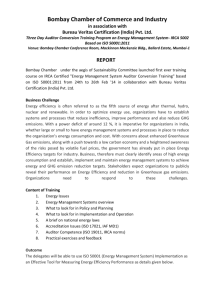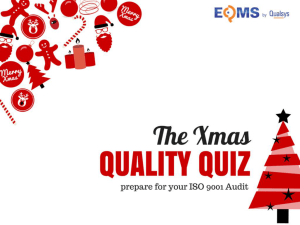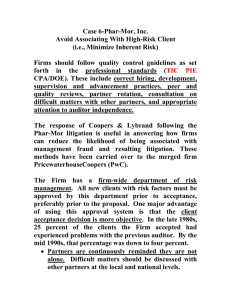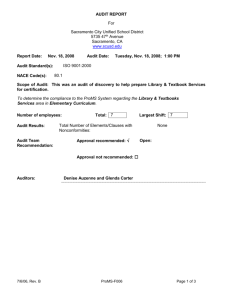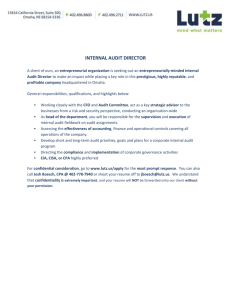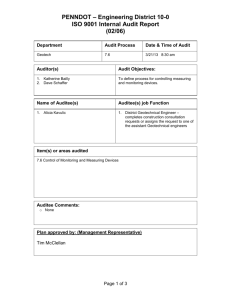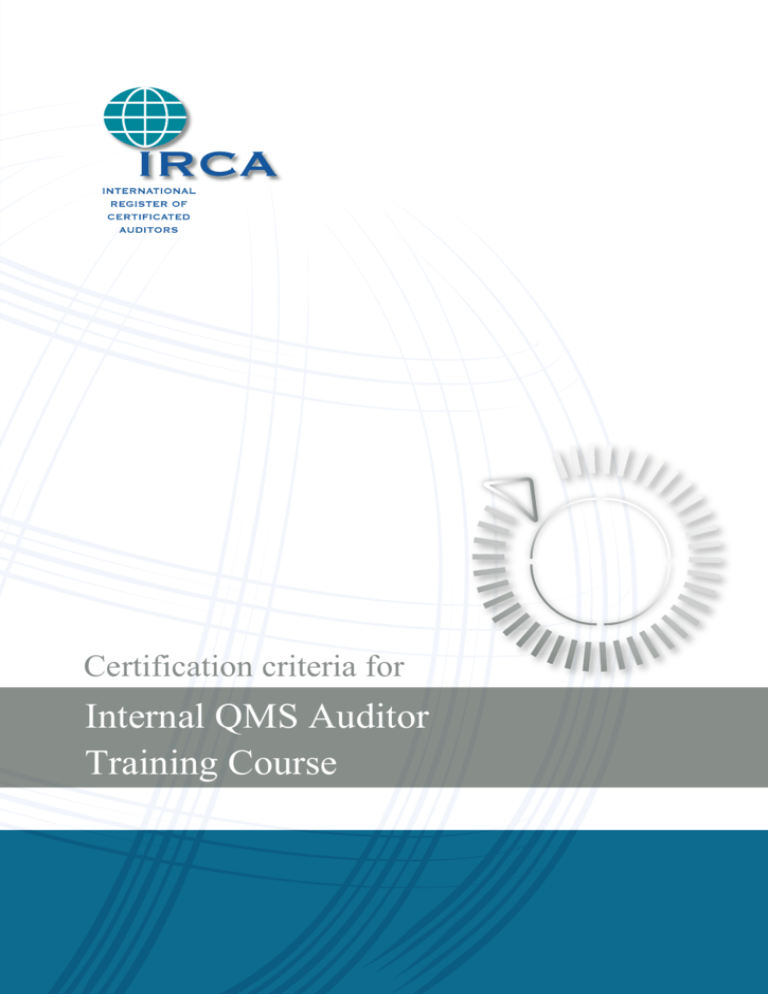
Certification criteria for
Internal QMS Auditor
Training Course
INTERNAL QMS AUDITOR TRAINING COURSE CRITERIA ________________________________________________________________________________________ CONTENTS 1. INTRODUCTION 2. LEARNING OBJECTIVES 3. ENABLING OBJECTIVES – KNOWLEDGE & SKILLS 4. TRAINING METHODS 5. COURSE CONTENT 6. COURSE DURATION 7. TUTORS AND STUDENTS 8. VARIATIONS 9. STUDENT ASSESSMENT 10. COURSE PUBLICITY AND ADVERTISING APPENDIX 1: INTERNAL AUDITOR STUDENT ASSESSMENT: GUIDANCE AND EXAMPLES Copyright IRCA – 2004 All rights reserved. No part of this publication may be reproduced, stored in a retrieval system or transmitted in any form or by any means ­ electronic, mechanical, photocopying, recording or otherwise ­ without prior permission of the CQI International Register of Certificated Auditors (IRCA)
Page 2 of 15 IRCA/2180/07/1 Jan 07 INTERNAL QMS AUDITOR TRAINING COURSE CRITERIA ________________________________________________________________________________________ 1. INTRODUCTION 1.1 We, the International Register of Certificated Auditors (IRCA), have developed this document to help you, the approved Training Organisation, achieve certification of your Internal QMS Auditor training course. 1.2 Before designing an Internal QMS Auditor training course to meet the requirements of this document you should consider the following: 1.2.1 The IRCA QMS 2000 program. ISO 9001:2000 provides industry with a useful model for business process improvement. Within this model ISO 9001:2000 identifies the internal audit process as a vital tool in the maintenance and continual improvement of a customer­focused, process­ based quality management system. 1.2.2 Aim of this course. The aim of the Internal QMS Auditor training course is to provide students who intend to perform internal audits with the knowledge and skills needed to assess and report on the conformance and effective implementation of processes, through internal audit, and to contribute to the continual improvement of the management system. For students from organisations intending to register their quality management systems against ISO 9001:2000, this course meets the minimum training required by ISO 19011 for internal auditors. 1.2.3 QMS Auditor Certification (IRCA/602). For students from organizations intending to register their quality management systems against ISO 9001, this course meets the minimum auditor skills training required by ISO 19011 for internal auditors. In order to satisfy the training requirement to become an IRCA certified Internal QMS Auditor however, students will need to complete the 1­day QMS Foundation course (IRCA/2001) in addition to this course. 1.2.4 Prior knowledge. Students are not expected to have knowledge of auditing, quality management systems or ISO 9001:2000 before attending the course. 1.2.5 Reference documents. This document references ISO 9001:2000 as the management system standard that provides the context for the internal audit. However, this course does not address ISO 9001:2000 in detail, and students will not be able to audit against all ISO 9001:2000 requirements on completing this course alone. Where students are required to have a detailed knowledge of ISO 9001:2000, we recommend that the Internal QMS Auditor course is presented in conjunction with the ISO 9000:2000 Series Foundation Course, (IRCA/2001). 1.2.6 Training vs Assessment. There must be two distinct aspects to courses based on these criteria: a) Effective training to help students develop the knowledge and skills defined in this document. b) Effective assessment of each individual student’s achievement of the learning objectives through objective testing based on defined outputs.
Page 3 of 15 IRCA/2180/07/1 Jan 07 INTERNAL QMS AUDITOR TRAINING COURSE CRITERIA ________________________________________________________________________________________ 1.2.7 Flexibility in course design. Your training course must be designed and delivered in accordance with the criteria in this document, although you may exercise flexibility in the inclusion of additional learning objectives, additional material, and in the structure and selection of specific training methods used during the course. Many of the certification requirements common to the management and control of courses are detailed in IRCA/2000; Requirements for Training Organization Approval. These requirements are in addition to the requirements of IRCA/2180 and are mandatory. It is essential, therefore, that you are familiar with the requirements of IRCA/2000. 1.2.8 Training methods. This course may be designed to be presented in a variety of ways: a) Classroom­based over 2 days full­time (i.e. over two consecutive working days). b) Classroom­based as a series of part­time modules over a longer period. c) Blended as a combination of self­study (i.e. e­learning course, correspondence course etc) and classroom­based learning. However it is designed, students must complete the whole course of study with your organization. Note: we will not accept courses that are wholly based on self­study learning. 2. LEARNING OBJECTIVES 2.1 L earning Objectives describe in outline what successful students will know and be able to do by the end of the course. By the end of the course students will be able to: Knowledge 2.1.1 Describe the responsibilities of an internal auditor and describe the role of internal audit in the maintenance and improvement of management systems (see 3.1). 2.1.2 Describe with reference to the Plan, Do, Check, Act (PDCA) cycle and the Model of a Process­based Quality Management System, the purpose and structure of ISO 9001:2000 (see 3.2). Skills 2.1.3 Plan, conduct and report an internal audit of part of quality management system in accordance with ISO 19011 (see 3.3).
Page 4 of 15 IRCA/2180/07/1 Jan 07 INTERNAL QMS AUDITOR TRAINING COURSE CRITERIA ________________________________________________________________________________________ 3. ENABLING OBJECTIVES – SKILLS & KNOWLEDGE In order for students to achieve the overall Learning Objectives, they will need to acquire and develop specific knowledge and skills. These are specified below as Enabling Objectives and can be considered as steps to the achievement of Learning Objectives. 3.1 Describe the responsibilities of an internal auditor and describe the role of internal audit in the maintenance and improvement of management systems. Knowledge 3.1.1 Define what a management system is, including: a) The purpose and typical structure of management systems. b) The significance of policies, objectives and processes in the management system. 3.1.2 Define an internal audit, including: a) The terms and definitions used in auditing, referencing 19011 and ISO 9000:2000. b) Typical objectives for audits, including conformance, effectiveness and improvement, and suggest how these different types of audit can add value to an organisation. c) The audit cycle. d) The responsibilities of auditors, and principles of auditing. 3.1.3 Planning, conducting and following up an audit: a) Explain the significance of audit criteria and give examples of types of different audit criteria. b) Explain the need for pre­audit contact with the auditee. c) Suggest approaches and methods for: o Planning an internal audit, including arrangements for opening and closing the audit. o Planning and conducting an audit of a process for which there are no documented procedures. o Gathering objective evidence to meet different audit objectives, including conformance, improvement and effectiveness audits. d) Explain the purpose and typical content of an internal audit report. e) Explain the purpose of and methods for follow up of audit findings. 3.1.4 Explain the role of IRCA in the certification of auditors.
Page 5 of 15 IRCA/2180/07/1 Jan 07 INTERNAL QMS AUDITOR TRAINING COURSE CRITERIA ________________________________________________________________________________________ 3.2 Explain with reference to the Plan, Do, Check, Act (PDCA) cycle and the Model of a Process­based Quality Management System, the purpose and structure of ISO 9001:2000. Knowledge 3.2.1 Explain why organisations use ISO 9001:2000, including: a) The purpose and structure of ISO 9001:2000, with reference to the PDCA cycle and the Model of a Process­based Quality Management System. b) The relationship between management processes and realisation processes, and the implications for auditing. c) The ISO 9001:2000 clause 8.5.1 requirement for Continual Improvement and the implications of this for internal auditors. 3.2.2 Explain the requirements for Internal Audit as described in clause 8.2.2 of ISO 9001:2000. 3.2.3 Explain how audits can be used as a tool for the maintenance and improvement of management systems. 3.3 Plan, conduct and report an internal audit of part of quality management system in accordance with ISO 19011. Skills 3.3.1 Establish the purpose and objectives of the audit, define the audit scope and identify the documents to be reviewed and information to be obtained before the audit. 3.3.2 Produce an outline plan for auditing the conformance and effectiveness of a process, including: a) What to audit (documents, records, activities). b) Who to select for interview. c) Where and when to audit (including locations, sequence, audit trails etc). d) What methods to use for gathering objective evidence (e.g. interview, observation, review of documents and records). 3.3.3 Produce an audit plan and audit checklist (or alternative) appropriate for the scope, objective and audit criteria for use in the practical audit exercise(s). 3.3.4 Apply the audit checklist (or alternative) in a practical audit situation to: a) Gather objective evidence to achieve the audit objectives through a structured audit interview and the sampling of documents and records. b) Follow audit trails to determine the effectiveness of processes. c) Take appropriate notes. d) Demonstrate effective questioning, listening, observation and feedback skills in gathering of objective evidence in an audit situation.
Page 6 of 15 IRCA/2180/07/1 Jan 07 INTERNAL QMS AUDITOR TRAINING COURSE CRITERIA ________________________________________________________________________________________ 3.3.5 Review audit evidence against criteria and determine: a) The effectiveness of the activity/process in achieving planned results. b) Conformance to defined audit criteria. c) Opportunities for improvement. 3.3.6 Link audit findings to establish root cause of non­conformance. 3.3.7 Write clear, actionable audit reports. 3.3.8 Plan a follow­up audit including methods to be used to obtain objective evidence that corrective action is effective. 3.3.9 Determine the effectiveness of corrective actions taken in given situations. 4. TRAINING METHODS 4.1 Your course may be presented as a wholly classroom­based course or as a blended course (in other words part self­study and part classroom­based). You may also present the course as a series of separate modules, either as full­time or part­time study. 4.2 Classroom­based training 4.2.1 You must provide for students an environment conducive to effective learning. At the beginning of the course you must provide the students with a description of the learning objectives, course structure, format and programme, student responsibilities and the assessment processes and assessment criteria, and you must deal with any concerns or worries that students may have. 4.2.2 Your course must be based on the learning cycle (see guidance in Appendix 1) and include opportunities for students to:
·
Experience new ideas and skills. (Note that tutor­led slide presentations as a sole method to help students learn new knowledge is not acceptable).
·
Reflect on their learning and identify strengths and weaknesses. (Note that your course must include methods for monitoring and providing time for tutors and students to review tasks and activities and each student’s achievement of the learning objectives).
·
Address and improve on areas of weakness. (Note that your course must include provision for review and remedial work, and individual coaching, where necessary.) 4.2.3 Your course must include a variety of learning methods to suit the range of learning styles (see guidance in Appendix 1). 4.2.4 Your course must not rely on tutor presentations and tutor­led discussions to teach knowledge­based learning objectives. We expect to see students learning these elements mostly through a process that requires students to complete a task or activities, often in teams, and to produce a defined output. 4.2.5 All students must practise the skill­based learning objectives of the course (learning objective 2.1.3) through participation in appropriate tasks and activities (role play, simulation etc).
Page 7 of 15 IRCA/2180/07/1 Jan 07 INTERNAL QMS AUDITOR TRAINING COURSE CRITERIA ________________________________________________________________________________________ 4.2.6 Timekeeping, planning and programme management are essential elements in the performance of an audit and, although we recognise that effective training is responsive to students’ needs, deviations from the timetable must be managed so that all learning objectives are adequately covered and students are kept informed of significant changes to the programme. 4.2.7 You must submit session plans or tutor notes for each individual training session. Session plans must specify:
·
·
·
·
·
·
learning objectives and duration for the session
nature of the activity and training method to be used
organizational arrangements, tutor and student briefing details
deliverables required from students for practical sessions
materials, exercises and equipment required to run the session
where training methods or use of exercises etc. are optional, this must be clearly indicated in session plans. Note that the format of your session plans will depend on your approach to tutor competence and training and the size and complexity of your organization. Medium and high complexity training organizations (see IRCA/3000 appendix) will require more comprehensive tutor notes to ensure that training in new and amended materials is controlled and effective. 4.3 Blended courses (a combination of self­study, including electronic media, and classroom based learning) 4.3.1 Only knowledge­based learning objectives 2.1.1 and 2.1.2 may be covered by self­study methods. 4.3.2 Learning objective 2.1.3 (auditing skills) must be completed in a classroom environment in terms of practice and student assessment. See clause 4.2 of this document for requirements for the classroom element of blended learning courses. 4.3.3 Training methods selected should seek to involve and engage students throughout the duration of the course. Simply providing students with a set of reading materials will not be acceptable. Your self­study materials must be designed around a clearly structured learning process with: § Theory. § Examples (scenarios, case studies etc). § Practice (activities, case studies, progress tests etc). § Feedback/self­assessment on activities and tests where relevant, to ensure students can self­assess their understanding and achievement of the learning objectives and identify any areas requiring further work. 4.3.4 Self­study course materials must be clearly presented and structured for ease of use, with appropriate navigational aids. You must make the following clear to students to help them manage their learning: § The learning objectives for the overall self­study element of the course. § The learning objectives for each section within the course. § How the self­study element of the course links with the classroom component
Page 8 of 15 IRCA/2180/07/1 Jan 07 INTERNAL QMS AUDITOR TRAINING COURSE CRITERIA ________________________________________________________________________________________ § The structure and suggested or intended sequence of the materials. § Instructions for the students’ use of the materials, including realistic timescales. § Examples of typical documents, reports, forms etc. § How, when and how often students may contact tutors for help, guidance and feedback. § Methods for students to assess their learning and to seek timely feedback and coaching from the tutor(s). 4.3.5 You must ensure that each student has timely access to a course tutor to answer questions and queries. Note: as a guide, a response to communications from students within 24 hours would be acceptable. 5. 6. COURSE CONTENT 5.1 At the beginning of the course you must provide the students with a description of the Learning Objectives, course structure, format, their responsibilities, student assessment processes and criteria. 5.2 The course must cover all aspects defined in clause 2, Learning Objectives, and clause 3, Enabling Objectives. 5.3 The course must cover the benefits of certification as an IRCA Internal QMS Auditor, including brief details of the IRCA QMS auditor certification scheme, and provide students with details of how to contact IRCA and apply for certification. You must use IRCA/190 and IRCA/167 (or equivalents) for this purpose. COURSE DURATION 6.1 Classroom­based learning 6.1.1 Where the course is wholly classroom­based, the total course must be at least 14 hours net, calculated as detailed in IRCA/2000. 6.1.2 This course may be presented over a minimum of 2 consecutive days full­ time or on a part­time (modular) basis over a maximum of 4 weeks. Note: although not mandatory, we recommend that this course be residential if presented over consecutive days. 6.2 Blended learning 6.2.1 Elements of the courses that are delivered through self­study will allow students three times longer than classroom training (i.e. approximately 18 hours for learning objectives 2.1.1 & 2.1.2).
Page 9 of 15 IRCA/2180/07/1 Jan 07 INTERNAL QMS AUDITOR TRAINING COURSE CRITERIA ________________________________________________________________________________________ 6.2.2 The classroom element (i.e. the skills learning objective 2.1.3 as a minimum) must be timed to allow each student to practise and be assessed on the skills learning objective. The amount of time given to the classroom element will depend on the learning objectives being covered. As a guide we expect a minimum of 7 hours over 1 day to be spent on the practice and assessment of the learning objective 2.13. Courses with a reduction in classroom time may be allowed if agreed in advance with IRCA. See the Appendix for guidance for instances where reduced classroom time may be allowed. 6.2.3 Each student must complete the both the self­study and the classroom part of the training course in no more than 90 days. 6.2.4 Students must complete each element of blended courses in the correct sequence. For example, for courses designed with a self­study element that is to be followed by a classroom element, you must ensure that students who do not complete the self­study element of the course are not accepted onto the classroom­based element. You must have a process for recording and validating each student’s completion of each element of blended courses to ensure students complete the course in the correct order. 6.3 Translators 6.3.1 If the course is given through translators, the time must be increased as necessary to satisfy the learning objectives. 7. TUTORS AND STUDENTS 7.1 Student numbers: 7.1.1 The maximum number of students per course is 20. 7.1.2 The minimum number of students per course is 4. 7.2 The course must be run with at least one tutor, who must be present for the full duration of the course. 7.3 Self­study based learning: tutors who provide educational support on self­study elements of blended learning must be competent to operate any media required. 7.4 Tutors for this course must demonstrate competence in key attributes: 7.4.1 Competence in Training; by satisfying the Tutor requirements as appropriate (see IRCA/2000). 7.4.2 Competence in Auditing against quality management systems; by demonstrating auditing competence as a currently certified Internal QMS 2000 Auditor as described in IRCA/602 or meeting the requirements for such certification. 7.4.3 Competence to deliver training and student assessment on your specific course. 7.4.4 Knowledge of the specific local regulatory requirements in which the course is presented, or have a local expert attending at the necessary times.
Page 10 of 15 IRCA/2180/07/1 Jan 07 INTERNAL QMS AUDITOR TRAINING COURSE CRITERIA ________________________________________________________________________________________ 7.5 You must specify the tutor resource for all parts of the course, and be able to demonstrate to us that this is adequate for the effective delivery of the Course Content (clause 4) and the effective implementation of the Student Assessment (clause 9). Although we have not prescribed student:tutor ratios for elements of the course where students’ audit skills are assessed/tested (see clause 9), we consider it unlikely that one tutor would be able to assess effectively the performance of more than 12 students. Therefore, for groups larger than 12, you are advised to provide additional tutor resource during elements of the course where audit skills are assessed. We will review the effectiveness of the specified tutor resource specified during the application process, and review its effective implementation during the surveillance process. 8. 9. VARIATIONS 8.1 We will consider requests for variations to any of these criteria, or in respect of any special circumstances. In this situation you should submit a written request to us immediately the requirement for the variation becomes apparent. 8.2 We will consider the following when evaluating any request for variation:
·
Reasons for the requested variation.
·
Proposed modifications to the training.
·
The impact on the learning and assessment processes and how this will be managed. STUDENT ASSESSMENT 9.1 In order to satisfactorily complete the course each student must: 9.1.1 Complete all elements of the course, covering all Learning and Enabling Objectives. 9.1.2 Pass the student assessment. 9.2 Student assessment: 9.2.1 Students must demonstrate acceptable performance in the Learning Objectives (clause 2.1) to successfully complete the course. 9.2.2 You must provide each student with feedback on his or her achievement of these learning objectives as described in IRCA/2000. 9.2.3 You must specify how each Learning Objective will be assessed within the following minimum requirements: a) Objectives 2.1.1 and 2.1.2 must be assessed through written quiz or examination, for which each student is awarded an individual mark. b) Objectives 2.1.3 must be tested through relevant practical activity with written output, undertaken by students individually or in small groups and through each student’s individual performance in a practical audit situation. Where small groups are used, you must specify arrangements for ensuring the understanding and active contribution of each student. An example of how you could approach student assessment is given in Appendix 1.
Page 11 of 15 IRCA/2180/07/1 Jan 07 INTERNAL QMS AUDITOR TRAINING COURSE CRITERIA ________________________________________________________________________________________ 10. COURSE PUBLICITY & ADVERTISING 10.1 Your training course advertising and promotional material must not state nor imply that this course fulfils more than part of the training requirements for certification as a QMS 2000 Internal Auditor.
Page 12 of 15 IRCA/2180/07/1 Jan 07 INTERNAL QMS AUDITOR TRAINING COURSE CRITERIA ________________________________________________________________________________________ APPENDIX: NOTES FOR GUIDANCE Helping students learn new knowledge & skills We promote the use of accelerated learning approaches because they are more efficient, in terms of speed and depth of comprehension, and more effective, in terms of long­term retention of new knowledge. Therefore, you should employ practical tasks and activities to help students to understand new concepts and ideas. You should not rely on tutor­focused lecture/presentation to transfer new ideas and concepts. 1. The Learning cycle There is a clear link between Deming's familiar Plan­Do­Check­Act and the learning cycle: a. students experience something (e.g. complete a task to find out about the requirements of ISO 9001) b. students reflect on what they did & identify what they learned and what they still don't fully understand or can't do (e.g. feedback to compare their answers to other students’ answers and / or model answers, and identify any problems) c. students take action to address weak areas. (e.g. ask tutor for help or complete task/activity again or complete another task) Ensuring that your training sessions follow this simple model will make students' learning more effective. We referenced the learning cycle described by David A Kolb in developing these criteria and you might find it useful to consider this when developing your course. 2. Learning styles We promote a variety of training methods in your course design. Different people learn in different ways so your sessions should follow the learning cycle and your course should include a variety of different learning activities to cater for all needs as far as possible. Honey and Mumford (Learning Style Questionnaire, Peter Honey Publications, ISBN 1 902899 07 5) provide one model for describing different learning styles that you may find useful as a basis. 3. Session plans Developing session plans is a natural part of designing learning and training processes. Session plans should be simple and easy to use working documents to help your tutors manage effective learning. For organizations with only a few tutors, outline session plans are acceptable. For larger organizations with a number of branches or subcontractors, and the consequent number and turnover of tutors, we will require more comprehensive session plans. A sample session plan is provided below. 4. Continuous assessment Continuous assessment should have a clear link between: session plans (for tutors), clear task/activity instructions with defined and measurable outputs (for students and tutors), activity marking schemes / model answers (for tutors), model answers (for students), individual student continuous assessment record (for recording student performance). Blended Learning – course duration & tutor:student ratios We will consider courses designed with less than 60% of the course duration (as calculated in IRCA/2000) devoted to classroom activity in circumstances where, for example, there is a smaller tutor:student ratio: for example 2 tutors and a maximum of 6 students.
Page 13 of 15 IRCA/2180/07/1 Jan 07 INTERNAL QMS AUDITOR TRAINING COURSE CRITERIA ________________________________________________________________________________________ Self­Study We recommend that you consider the following documents when developing training based on information technology solutions: BS 7988:2002 A Code of Practice for the use of information technology for the delivery of assessments BS 8426:2003 A Code of Practice for e­support in e­learning systems
Page 14 of 15 IRCA/2180/07/1 Jan 07 INTERNAL QMS AUDITOR TRAINING COURSE CRITERIA ________________________________________________________________________________________ Example continuous assessment options The following table provides examples of how you could assess/test student achievement of the Learning Objectives and how feedback and follow­up work could be approached: the items in white boxes are examples only. Learning Objective IRCA requirement for testing Example arrangement for testing Example Pass Criteria Example Feedback to students Describe the responsibilities of an internal auditor and describe the role of internal audit in the maintenance and improvement of management systems. Written (Quiz / exam etc) Quiz at the end of the morning of day 1. Min pass mark 70% Verbal during review of quiz. Explain with reference to the PDCA cycle and model of a process­ based quality management system the purpose and structure of ISO 9001 Written (Quiz / exam etc) Quiz at the end of day 1. Min pass mark 70% Plan and prepare for an internal audit, including preparing a checklist Practical activity with written output. Written notification of mark. Verbal during review of quiz. Written notification of mark. Remedial work with any failures. Day 1: preparation of checklist exercise. See marking scheme. Min score 7 out of 10 Tutors to review progress and coach students as appropriate during the exercise. Written comments and score to be provided day 2 a.m. Gather objective evidence through interview and sampling of documents. Observed practical activity. Write factual audit reports that help to improve the effectiveness of the management system Practical activity with written output. Suggest ways in which the effectiveness of corrective actions might be verified. Quiz / exam Day 2: audit role­ play. Tutors to allocate a “competent” or “not yet competent” mark to each student for each of the enabling objectives in section 3.4 Verbal feedback following the exercise. Remedial work with any failures. Day 2: reporting on the audit role­ play exercise. See marking scheme. Min score 7 out of 10 Verbal feedback following the exercise. Remedial work with any failures. Score to be notified to students at the end of the course. Short Test day 2. Min pass mark 7 out of 10 Papers to be marked after the course and result notified to students after the course.
Marks to be allocated at the end of the course. Page 15 of 15 IRCA/2180/07/1 Jan 07

